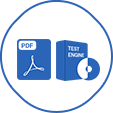Last Update 11 hours ago Total Questions : 119
The ITIL 4 Foundation Exam content is now fully updated, with all current exam questions added 11 hours ago. Deciding to include ITIL-4-Foundation practice exam questions in your study plan goes far beyond basic test preparation.
You'll find that our ITIL-4-Foundation exam questions frequently feature detailed scenarios and practical problem-solving exercises that directly mirror industry challenges. Engaging with these ITIL-4-Foundation sample sets allows you to effectively manage your time and pace yourself, giving you the ability to finish any ITIL 4 Foundation Exam practice test comfortably within the allotted time.
Which is the definition of an IT asset?
Which practice guarantees that users nave a range of access channels to choose from to report problems?
Which organization delivers output or outcomes of a service?
Which describes an unresolved problem which has been already analysed?
Which TWO of the following statements are MOST associated with the optimize and automate' guiding principle?
1. It is important to assess which method of communication is appropriate 'or each type of stakeholder.
2. Complex systems should be designed with an understanding of how the components' parts are related.
3. Organizations should consider whether technology could improve the eficiency o' manual processes.
4 It is important to understand the organization's objectives when assessing the impact of potential improvements.
Which practice MOST requires staff who demonstrate skills such as empathy and emotional intelligence?
Which statement about emergency changes is CORRECT?

